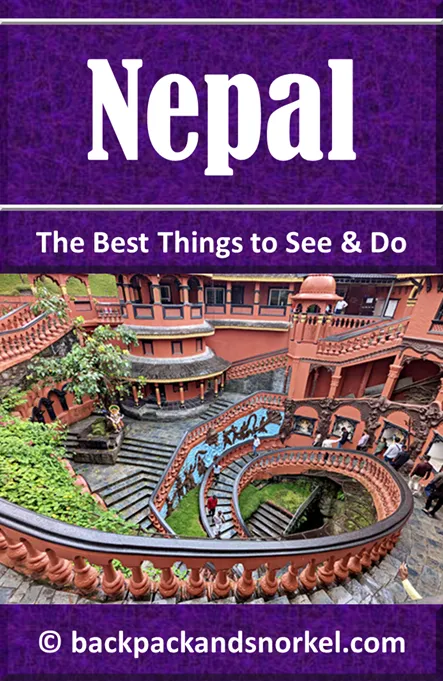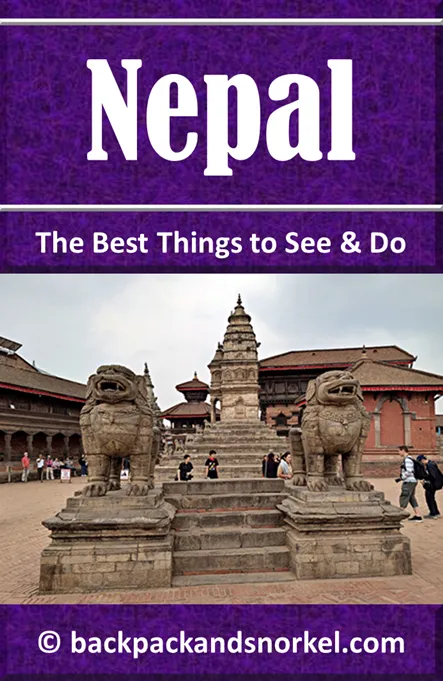Unlock Bhaktapur Durbar Square: Your Ultimate Self-Guided Walking Adventure - Nepal Purple Travel Guide
(map, reviews)
This is Premium Content! To access it, please download our
Backpack and Snorkel Purple Travel GuideBhaktapur Durbar Square is the third Durbar Square that you are visiting. It used to be the largest and most magnificent of the three, featuring extensive palace complexes, temples, and courtyards, but most of its buildings have been lost to history. What is left today is still a stunning display of Malla architecture and definitely worth a visit.
Here at Backpack and Snorkel Travel Guides, we typically promote self-guided walking tours.
But we realize that not everybody likes to walk by themselves in a foreign city. So, just in case that you rather go with ab guide: NO PROBLEM! Please see the Viator tours below.
free GuruWalk tours
paid Viator tours
The Origin of the Name Bhaktapur Durbar Square
The term ‘Durbar Square’ is a generic name used for the royal palace squares of the Malla period and can also be found in Kathmandu and Patan.
Cultural and Historical Significance
Bhaktapur Durbar Square is a former royal palace complex located in Bhaktapur, Nepal.
It began taking shape during the Licchavi period (approx. 3rd to 9th century AD), but the palace complex and many of its iconic structures were primarily developed during the Malla period, particularly from the 12th century onward.
The square as we know it today, with its grand temples, courtyards, and palace buildings, was significantly expanded and embellished between the 14th and 18th centuries by various Malla kings, especially during the reigns of:
King Yaksha Malla (reigned 1428–1482), who is credited with constructing parts of the royal palace complex and enhancing the urban layout.
King Bhupatindra Malla (late 17th to early 18th century), who built iconic structures like the 55-Window Palace and the Golden Gate.
Bhaktapur Durbar Square served as the royal seat of the Malla kings of Bhaktapur, who ruled from the 14th century until the late 18th century, when the Kingdom of Bhaktapur was annexed by Prithvi Narayan Shah in 1769 during the unification of Nepal.
Today, Bhaktapur Durbar Square is a UNESCO World Heritage Site, jointly managed by the Department of Archaeology, Nepal and Bhaktapur Municipality.
Among Kathmandu’s three Durbar Squares: Katmandu Durbar Square, Patan Durbar Square, and Bhaktapur Durbar Square was historically considered the largest and most magnificent, featuring extensive palace complexes, temples, and courtyards.
At its peak, the square reportedly contained 99 courtyards (bahals or chowks), but today only around 15 remain. Many structures were lost to a series of devastating earthquakes, especially those in 1833, 1934, and 2015. While restoration efforts have preserved some of its architectural heritage, much of the original grandeur has been lost.
Self-Guided Walking Tour of Bhaktapur Durbar Square
As with the other two Durbar Squares, you will need to pay admission to enter. At the time of writing, admission is Rs1,800 per person, cash-only. If you don’t have enough cash on hand, don’t worry. There are ATMs to the left of the ticket booth on the western side of Bhaktapur Durbar Square.
We did not see any payment booths at the eastern entrance. Chances are that, if you enter from the east, a guard will come and ask you to go to the payment booth and pay.
Please be advised that the 2015 earthquake caused severe damage to many structures in Bhaktapur Durbar Square. Some of the buildings described in older travel guides don’t exist anymore, while quite a few others are fenced off while they are under construction.
You will also see few wooden poles supporting several walls that are leaning and would otherwise collapse.
In this guide, you will only find structures that can be accessed at the time of writing.
Bhaktapur Durbar Square is open 24/7, and admission is typically collected from 9am – 6pm.
The following map shows the points of interest in Bhaktapur Durbar Square:
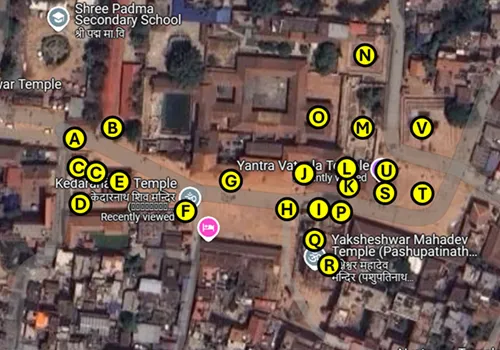
- Entrance Gate
- Ugrachandi & Bharib Statues
- Jagannath Temple and Rameshwar Temple
- Badrinath Temple
- Gopinath Krishna Temple with Garuda Statue
- Kedāranātha Temple
- National Art Museum
- Statue of King Bhupatindra Malla
- Taleju Bell
- The Golden Gate
- The Palace of 55 Windows
- Yama Dwar Chowk
- Dathu Chowk
- Lun Hiti / Golden Fountain
- Bhairav Chowk at Thanthu Durbar
- Chyasalin Mandap Pavilion and Layaku Hiti
- Vatsalā Durga Temple
- Yaksheshwar Mahadev Temple and Guhyeshwari of Bhaktapur
- Siddhi Laxmi Temple and Shankharnarayan Temple
- Twin Stone Lions
- Yantra Vatsala Temple
- Shilu Mahadev Temple
Entrance Gate
(map)
This is Premium Content! To access it, please download our
Backpack and Snorkel Purple Travel GuideThe Main Gate of is the starting point for most visitors exploring the royal square. While the gate itself may not be as old as the square's inner monuments, it stands as a formal boundary to the historic royal palace complex that once served the Malla kings of Bhaktapur (14th–18th centuries).
The gate is designed with some traditional Newari style features, like red brick walls, and royal symbols on top.
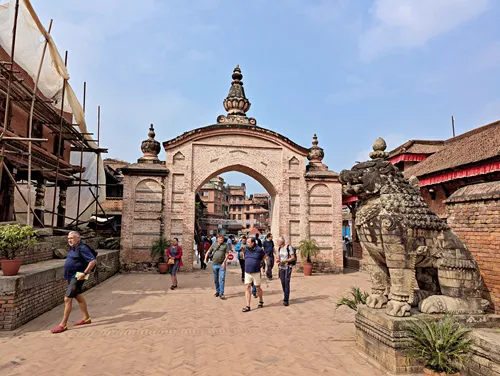
Ugrachandi & Bharib Statues
(map, reviews)
This is Premium Content! To access it, please download our
Backpack and Snorkel Purple Travel GuideLocated near the main entrance to the palace complex in front of the gate to a secondary school, these stone sculptures are not only remarkable late 17th century works of art, but also part of an interesting legend about their creator and King Bhupatindra Malla.
There is also an interesting legend about the creation of the Ugrachandi & Bharib Statues – we call it: The Legend of the Ugrachandi & Bharib Statues, and a King’s Obsession with Perfection
Detailed information can be found at our Ugrachandi & Bharib Statues Page
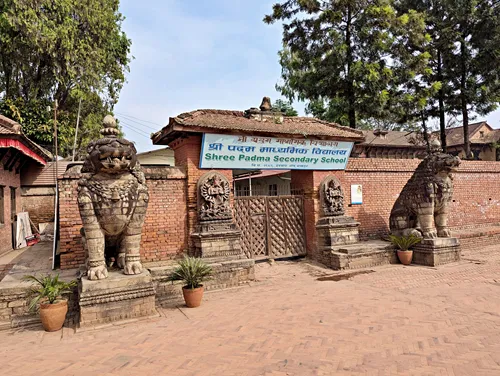
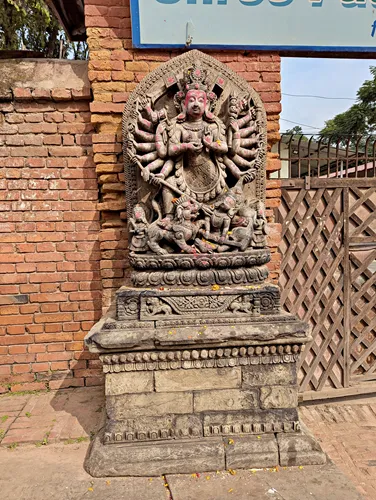
Jagannath Temple and Rameshwar Temple
(map, reviews)
This is Premium Content! To access it, please download our
Backpack and Snorkel Purple Travel GuideAcross the street (south) from the Ugrachandi & Bharib Statues you will see a group of four temples. They are the local Bhaktapur Durbar Square version of the four Char Dham temples.
Jagannath Temple was destroyed in the earthquake of 1934, and rebuilt as a simple rectangular building with white-washed walls. This building was destroyed in the 2015 earthquake and the temple is now being rebuilt in its original traditional Newar-style glory. Construction is still ongoing at the time of writing, but what you can see so far looks fantastic.
Rameshwar Temple is a shrine without walls on either side and a domed roof.
The shrine is believed to have been constructed during the reign of King Bhupatindra Malla in the late 17th or early 18th century.
Detailed information can be found at our Jagannath Temple and Rameshwar Temple Page
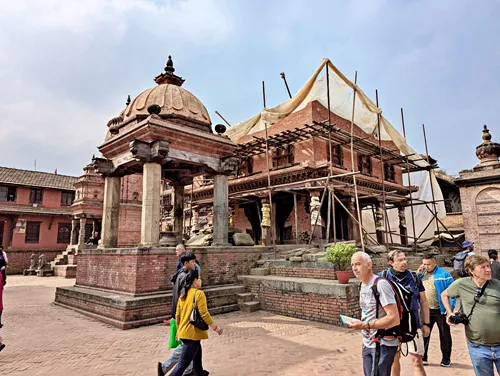
Badrinath Temple
(map, reviews)
This is Premium Content! To access it, please download our
Backpack and Snorkel Purple Travel GuideBadrinath Temple is part of the group of four Char Dham temples, which are the local Bhaktapur Durbar Square version of the four Char Dham temples in India.
The temple is named after Badrinath, one of the most revered forms of Lord Vishnu, whose principal shrine is located in the Indian Himalayas. In Hindu tradition, Badrinath is a divine protector and preserver of the universe. The name ‘Badrinath’ itself means ‘Lord of Badri’, referring to a mythical forest of berries (badri) where Vishnu is said to have meditated.
Detailed information can be found at our Badrinath Temple Page
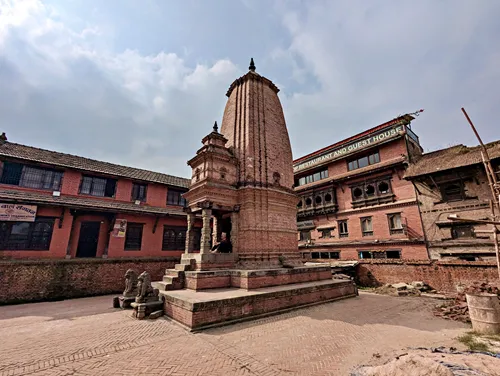

Gopinath Krishna Temple with Garuda Statue
(map, reviews)
This is Premium Content! To access it, please download our
Backpack and Snorkel Purple Travel GuideGopinath Krishna Temple is often called Radhakrishna Temple, Radha Krishna Temple, or Dwarikanath.
Built in traditional Newar style, it has the most spectacular wood carvings along the doors, struts, and windows we have seen in Kathmandu!
Gopinath Krishna Temple is part of the group of four Char Dham temples, which are the local Bhaktapur Durbar Square version of the four Char Dham temples in India.
Detailed information can be found at our Gopinath Krishna Temple with Garuda Statue Page
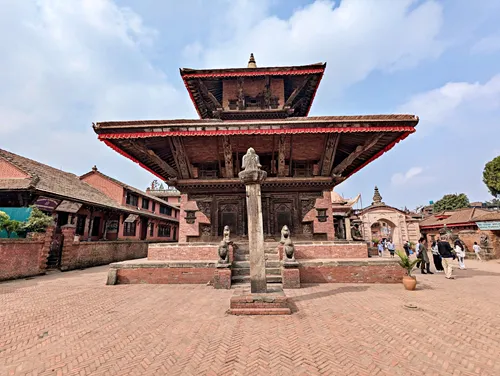
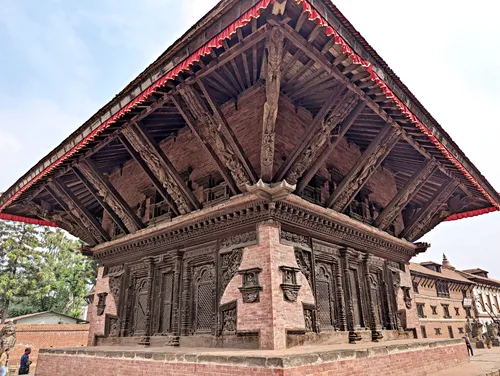
Kedaranatha Temple
(map, reviews)
This is Premium Content! To access it, please download our
Backpack and Snorkel Purple Travel GuideKedāranātha Temple stands in proximity of the four Char Dham temples, but is not part of that group.
Unlike the more common pagoda-style temples found throughout the Kathmandu Valley, Kedāranātha Temple is built in the shikhara style, similar to nearby Badrinath Temple. While Badrinath Temple has one entrance facing east, Kedāranātha Temple has four facing in all cardinal directions.
Detailed information can be found at our Kedāranātha Temple Page
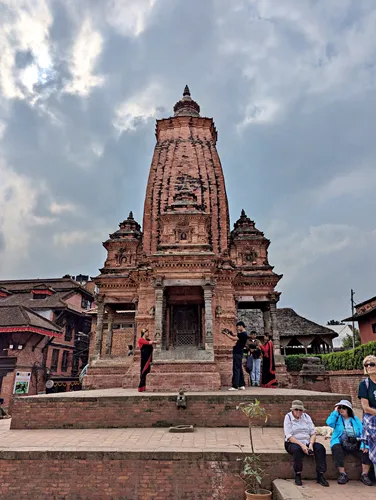
National Art Museum
(map, reviews)
This is Premium Content! To access it, please download our
Backpack and Snorkel Purple Travel GuideThe National Art Museum was established in 1960 by Nepal's Department of Archaeology, and officially inaugurated by Bishweshwar Prasad Koirala, Nepal’s first democratically elected Prime Minister and leader of the Nepali Congress.
The museum’s primary aim is to preserve and exhibit traditional Nepalese paintings and sculptures. It houses a collection that includes Paubha paintings (Nepalese religious scroll paintings), Tantric cloth paintings, manuscripts and chronicles dating as far back as the 11th century, and statues and icons made of bronze, brass, stone, and wood.
Detailed information can be found at our National Art Museum Page
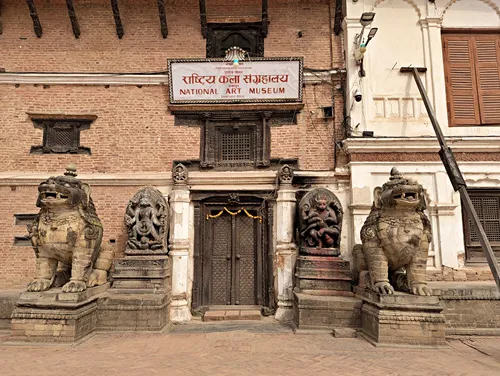
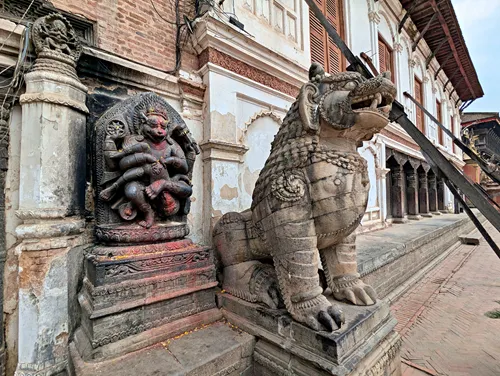
Statue of King Bhupatindra Malla
(map, reviews)
This is Premium Content! To access it, please download our
Backpack and Snorkel Purple Travel GuideAmong the many architectural wonders of Bhaktapur Durbar Square, one monument stands out for its grace, symbolism, and deep cultural significance: the Statue of King Bhupatindra Malla. Positioned prominently on a tall stone pillar in front of the Golden Gate facing the Taleju Temple inside the Royal Palace, this iconic statue pays tribute to the most celebrated monarch of Bhaktapur’s Malla dynasty.
King Bhupatindra Malla ruled Bhaktapur during the late 17th and early 18th centuries and is remembered as a visionary patron of the arts, architecture, and religion. His reign marked a golden age of cultural and artistic achievement, during which many of Bhaktapur’s most important temples and palaces were built or renovated.
Detailed information can be found at our Statue of King Bhupatindra Malla Page
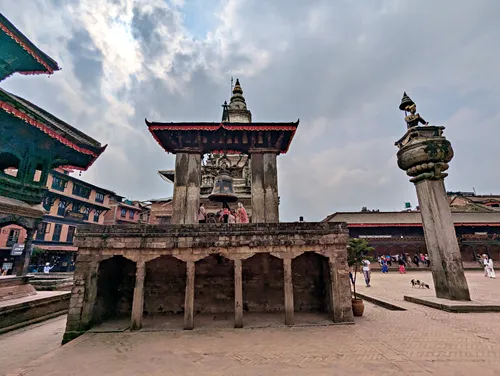
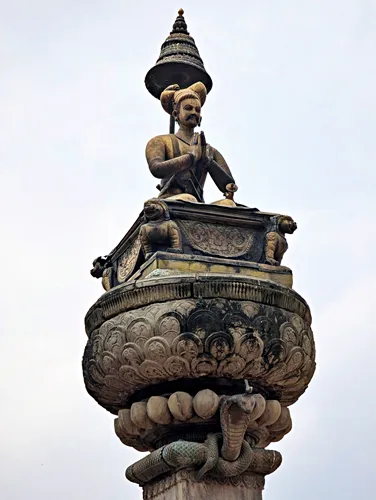
Taleju Bell
(map, reviews)
This is Premium Content! To access it, please download our
Backpack and Snorkel Purple Travel GuidePerched on a raised stone platform before the Golden Gate of Bhaktapur Durbar Square, the Taleju Bell is more than just a magnificent artifact; it’s a living emblem of devotion to Goddess Taleju Bhawani.
Crafted from cast bronze and embellished with gilt accents, the bell measures about 3 ft (1 m) in height and hangs from a wooden beam (roughly 10 ft (3 m) above the stone platform) set atop carved stone pillars.
Detailed information can be found at our Taleju Bell Page

The Golden Gate
(map, reviews)
This is Premium Content! To access it, please download our
Backpack and Snorkel Purple Travel GuideThe Golden Gate is one of Nepal’s most stunning architectural marvels. Revered for its intricate craftsmanship and historical significance, this gilded gateway draws travelers from around the world seeking to explore Nepal’s rich cultural heritage.
The Golden Gate is the main ceremonial entrance to the inner palace courtyard, which houses the Taleju Temple, a highly sacred space that was reserved for royalty and priests during the Malla period. The gate was constructed around 1753 by King Ranjit Malla (reigned from 1729 to 1769) as one of his final architectural contributions before Bhaktapur fell to the Gorkha conquest led by Prithvi Narayan Shah in 1769.
It is a brilliant example of traditional Newar art and metalwork, adorned with elaborate carvings of deities, mythical creatures, and floral motifs. Its gleaming surface is made of gold-plated copper, which gives the gate its iconic name.
Detailed information can be found at our Golden Gate Page
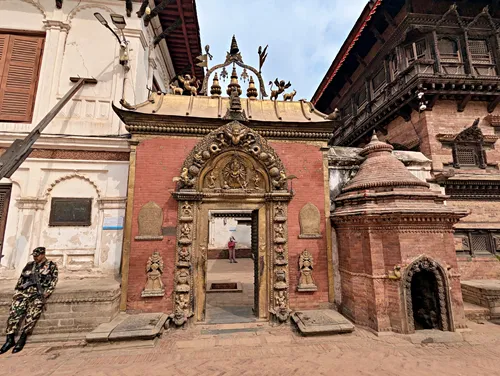
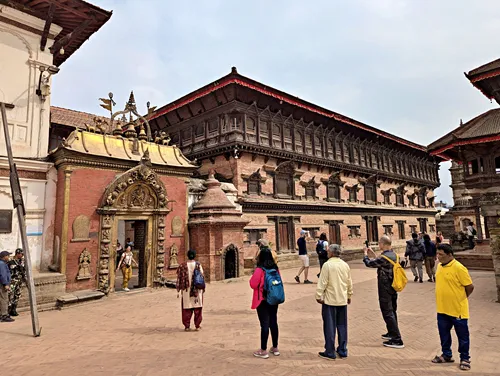
The Palace of 55 Windows
(map, reviews)
This is Premium Content! To access it, please download our
Backpack and Snorkel Purple Travel GuidePalace of 55 Windows is one of the most iconic landmarks in Bhaktapur Durbar Square. Celebrated for its intricate woodcarvings and grand design, this palace reflects the height of Newar artistry during the Malla dynasty.
The Palace of 55 Windows was originally constructed during the reign of King Yaksha Malla in the 15th century as a regular palace building.
Major reconstruction and expansion began in 1696, when King Bhupatindra Malla ascended to the throne of Bhaktapur. Known for his patronage of the arts and architecture, he transformed the palace into a masterpiece of Malla-era design, which served as the formal royal residence of the Bhaktapur Malla dynasty until 1769, when Prithvi Narayan Shah of Gorkha conquered Bhaktapur and ended Malla rule. The elaborate 55 intricately carved windows that now define the palace were part of this ambitious project.
Detailed information can be found at our Palace of 55 Windows Page

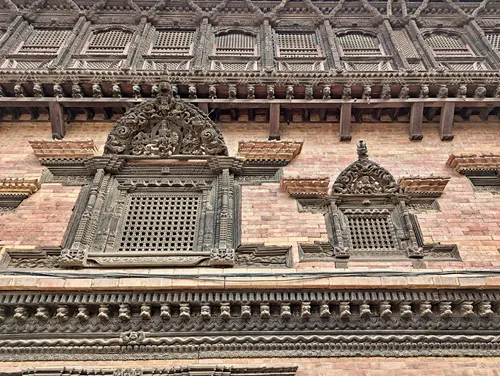
Yama Dwar Chowk
(map, reviews)
This is Premium Content! To access it, please download our
Backpack and Snorkel Purple Travel GuideAfter passing through the Golden Gate of the Bhaktapur Royal Palace, you will come to the first courtyard: Yama Dwar Chowk. Signs direct you to other parts of the palace that are currently open for visitors. Please be advised that there is a lot of restoration work ongoing to repair the damage for the 2015 earthquake.
Detailed information can be found at our Yama Dwar Chowk Page

Dathu Chowk
(map, reviews)
This is Premium Content! To access it, please download our
Backpack and Snorkel Purple Travel GuideDathu Chowk is an empty courtyard that is surrounded by beautiful Newar architecture.
Detailed information can be found at our Dathu Chowk Page
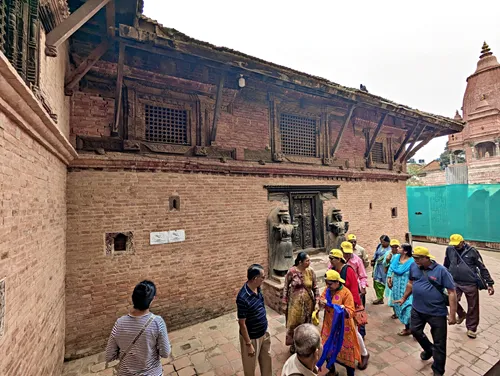

Lun Hiti / Golden Fountain
(map, reviews)
This is Premium Content! To access it, please download our
Backpack and Snorkel Purple Travel GuideLun Hiti, literally ‘Golden Fountain’ in Newar is one of Bhaktapur’s most enchanting water spouts. Carved in the 17th century under King Jitamitra Malla, this sunken hiti blends practical engineering, sacred ritual, and breathtaking Newari artistry.
Detailed information can be found at our Lun Hiti / Golden Fountain Page


Bhairav Chowk at Thanthu Durbar
(map, reviews)
This is Premium Content! To access it, please download our
Backpack and Snorkel Purple Travel GuideBhairav Chowk is an empty courtyard that is surrounded by beautiful Newar architecture.
Detailed information can be found at our Bhairav Chowk at Thanthu Durbar Page

Chyasalin Mandap Pavilion and Layaku Hiti
(map, reviews)
This is Premium Content! To access it, please download our
Backpack and Snorkel Purple Travel GuideIf you are templed out at this point, don’t worry, you get a short break. Chyasalin Mandap Pavilion is not a temple, and neither is Layaku Hiti.
Chyasalin Mandap was built in the 17th century, most likely during the reign of King Bhupatindra Malla of Bhaktapur (who ruled from 1696 to 1722). While there are local legends suggesting that King Srinivasa Malla of Patan may have initiated its construction as a symbol of friendship, the architectural style, inscriptions, and historical records most strongly associate the pavilion with King Bhupatindra Malla, who was a great patron of the arts and architecture in Bhaktapur.
Detailed information can be found at our Chyasalin Mandap Pavilion and Layaku Hiti Page
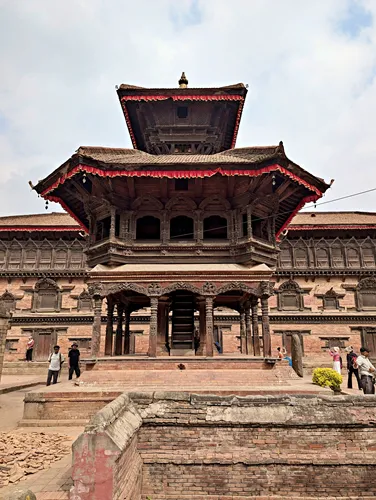
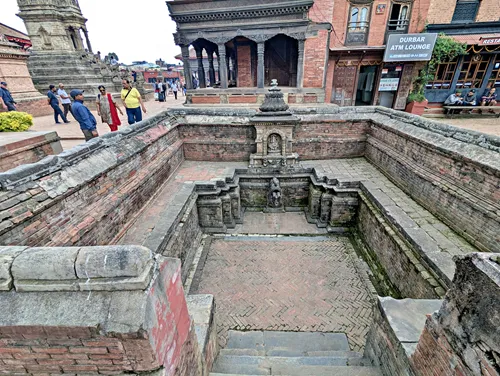
Vatsalā Durga Temple
(map, reviews)
This is Premium Content! To access it, please download our
Backpack and Snorkel Purple Travel GuideOne of the most elegant landmarks in Bhaktapur Durbar Square is the Vatsalā Durga Temple, a stone-built shrine that showcases the exquisite artistry of the Malla period. Though not as large as some of the nearby temples, its intricate carvings and graceful architecture make it a favorite among photographers and heritage lovers.
Vatsalā Durga Temple is built in Shikhara style, with ‘Shikhara’ being Sanskrit for ‘mountain peak’ or ‘tower’, referring to the tall, curvilinear tower that rises above the Garbhagriha (sanctum sanctorum), the innermost shrine where the primary deity is housed.
Detailed information can be found at our Vatsalā Durga Temple Page

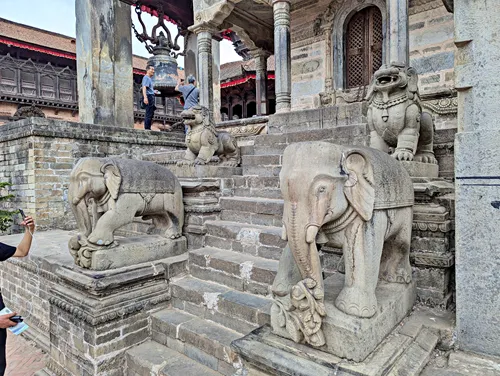
Yaksheshwar Mahadev Temple and Guhyeshwari of Bhaktapur
(map, reviews)
This is Premium Content! To access it, please download our
Backpack and Snorkel Purple Travel GuideYaksheshwar Mahadev Temple is often called Pashupatinath Temple of Bhaktapur. It is one of the oldest temples in Bhaktapur. Unfortunately, the 2015 earthquake collapsed the lower section of its pagoda-style roof. At the time of writing, the lower roof is still missing.
The Yaksheshwar Mahadev Temple was consecrated by Karpura Devi in 1484 and was dedicated to her deceased husband, King Yaksha Malla.
At the heart of the temple is a Shiva Lingam, a symbol of Shiva’s divine energy and creation. Temples to Lord Shiva, especially those housing a Shiva Lingam, are believed to radiate intense spiritual energy, some even say it can be fierce or overwhelming.
Detailed information can be found at our Yaksheshwar Mahadev Temple and Guhyeshwari of Bhaktapur Page
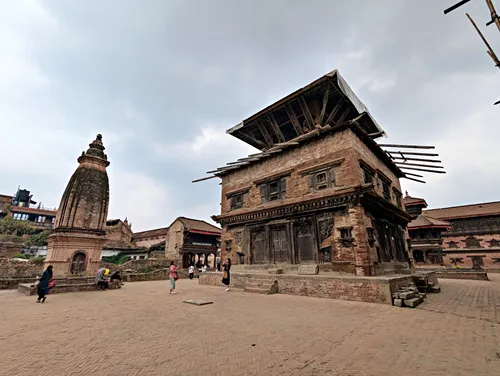
Siddhi Laxmi Temple and Shankharnarayan Temple
(map, reviews)
This is Premium Content! To access it, please download our
Backpack and Snorkel Purple Travel GuideLocated directly east of the Palace of 55 Windows is Siddhi Laxmi Temple, which is also spelled as Siddhi Lakshmi Temple.
This temple has a stairway with a unique arrangement of stairway guardian figures that sets Siddhi Laxmi Temple apart from almost every other temple in the Kathmandu Valley. Such stairway guardian figures in Nepal usually follow a more standard pattern (like lions, elephants, or mythical beasts), but this temple defies expectations - making it a rare and important example of symbolic storytelling in stone.
Detailed information can be found at our Siddhi Laxmi Temple and Shankharnarayan Temple Page


Twin Stone Lions
(map, reviews)
This is Premium Content! To access it, please download our
Backpack and Snorkel Purple Travel GuideThe Twin Stone Lions that stand in the middle of the large plaza east of Siddhi Laxmi Temple are also called Nimha Singha, and Lanpadegal. There always seem to be some people posing for photos with those statues.
Detailed information can be found at our Twin Stone Lions Page

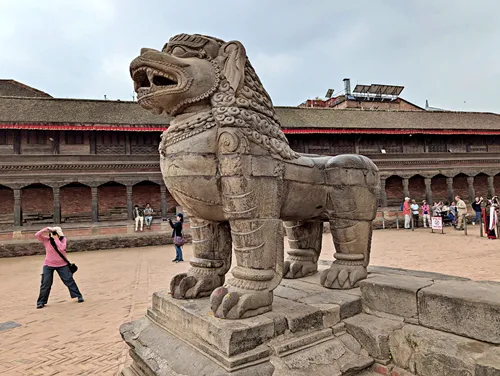
Yantra Vatsala Temple
(map, reviews)
This is Premium Content! To access it, please download our
Backpack and Snorkel Purple Travel GuideStanding directly behind Siddhi Laxmi Temple is a rectangular red brick building that looks different from all other buildings in Bhaktapur Durbar Square.
The temple stands on a slightly raised platform with a simple, compact structure. It features stone and brick construction, with wooden struts and minimalist but detailed carvings.
Detailed information can be found at our Yantra Vatsala Temple Page
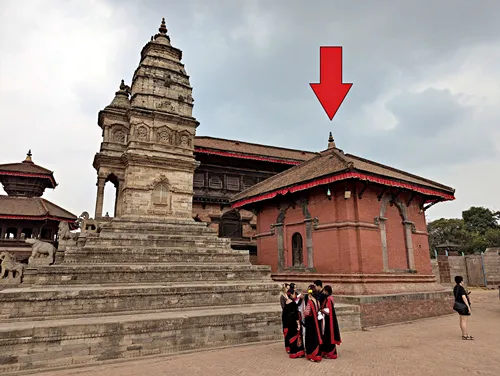
Shilu Mahadev Temple
(map, reviews)
This is Premium Content! To access it, please download our
Backpack and Snorkel Purple Travel GuideShilu Mahadev Temple is also known as Phasi Dega. It is one of the tallest temples in Bhaktapur Durbar Square, and if you climb up to the base of the temple, you will have a beautiful view.
Locals often refer to this temple as Phasi Dega or Phasidegal, which translates to ‘execution temple’. The name comes from an enduring urban legend that this site was once used for public executions or royal punishment. While there’s no concrete historical evidence to support this tale, the name persists, giving the temple an air of mystery and a vivid place in the collective memory of Bhaktapur.
Detailed information can be found at our Shilu Mahadev Temple Page

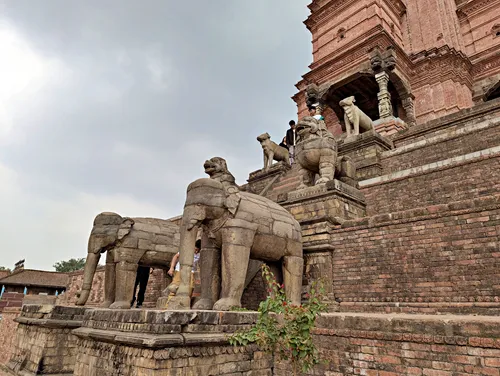
Back to your Day 4 in Nepal Itinerary
Author: Rudy at Backpack and Snorkel
Bio: Owner of Backpack and Snorkel Travel Guides. We create in-depth guides to help you plan unforgettable vacations around the world.
Other popular Purple Travel Guides you may be interested in:
Like this Backpack and Snorkel Purple Travel Guide? Pin these for later:

